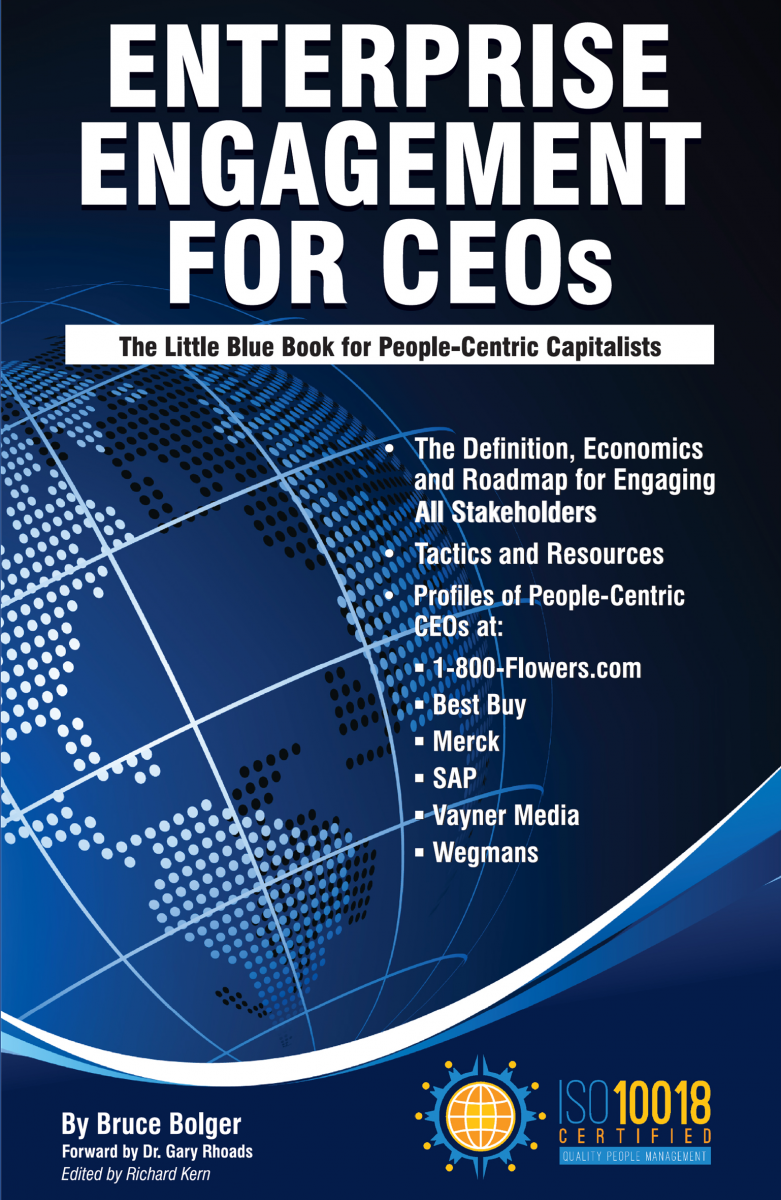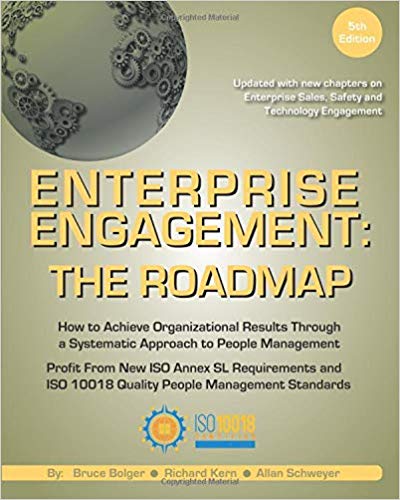CFO.com, one of the leading media platforms for chief financial officers, appears to be increasing its coverage of the emerging topic of human capital management and metrics. Ironically, CFOs are uniquely positioned to address the issues that have impeded the emergence of strategic human capital management and Stakeholder Capitalism principles, because they have influence not only with the CEO and board, and with human resources, but in all aspects of the organization from marketing to community engagement.
Note: The Enterprise Engagement Alliance is holding a one-hour webinar on human capital metrics and engagement return-on-investment on Tue., May 19, at 1 pm. Register here.
By Bruce Bolger

Like it or not, chief financial officers will be paying more attention to the money dedicated to human capital, comprised not only of the workforce, but also of customers, distribution and supply chain partners and communities. At most companies, expenditures for employees, customers and in some cases distribution partners consumes well over 50% of fixed expenses, and yet only a small percentage of organizations has a strategic and systematic approach to measuring the productivity, quality, or return-on-investment of efforts aimed at engaging employees, customers, distribution partners, or communities. With Depression-like economic conditions, how long can CEOs or CFOs ignore the general lack of effective human capital metrics to determine whether or not their investments in these many programs strategically and systematically align to deliver brand promises to all customers and stakeholders and achieve organizational goals?
The September 2019 issue of CFO magazine, “
Human Capital’s Big Reveal” flatly stated that the era of human capital measurement and metrics has arrived. “A climate ripe for extensive disclosure of human capital data is blanketing the corporate world, with European companies taking the initial lead. The United States has been lagging well behind, but in August the Securities and Exchange Commission proposed that companies be required to report on human capital ‘to the extent such disclosures would be material to an understanding of the registrant’s business.’”
Questions to Be Asked by CFOs
In CEO.com’s March edition, the article “
CFOs Should Not Leave Workforce Analytics Solely to HR,” the author argues, “Today, CFOs working closely with HR can use market and industry trends to identify workforce patterns and talent risks, forecast productivity, uncover recruitment and retention challenges, project ROI from HR initiatives, and pinpoint leadership opportunities that could otherwise be missed. CFOs can use talent data to bring strategic insight to talent acquisition and deployment by:
• Identifying ways to lower the cost of hiring, assigning, and engaging a productive workforce
• Ensuring compensation, benefits, and other rewards are aligned with business performance
• Targeting better ways of capturing ROI from HR development and well-being programs
• Determining and addressing signs of faltering performance
• Isolating mismatches in areas like benefits utilization
• Detecting and implementing process improvements across the workforce
In “
Managing Through Covid-19: Six Imperatives for CFOs,” published in April, the author writes: “CFOs must consider what needs to change in how the company operates and what opportunities can be seized during this time… During economic downturns, it’s natural to focus on cost-cutting; however, by staying the course on initiatives that support long- term growth, CFOs can play a critical role in financing and positioning their companies for recovery.” Despite the enormous number of unemployed, “Companies will likely continue to face the long-term talent shortages they have experienced in recent years, especially during and after the recovery. A downturn presents an opportunity to hire critical talent from other organizations and universities that may be forced to downsize as they deleverage. Furthermore, this unique circumstance can provide leaders an opportunity to ensure their digital transformation projects are intact.”
CFOs can play an important role in helping organizations improve sustainable performance through people in that they generally have significant influence not only with the CEO and board but also across the entire organization—human resources, sales and marketing, operations, legal, etc. The challenge is that CFOs have almost none of the training necessary to help CEOs make sense of their human capital metrics because the subject is barely taught in business schools, let alone in the accounting profession.
Impediments to Human Capital Management and Measurement
The three biggest impediments to human capital management and metrics are:
1. Lack of knowledge about human capital measurement and management in the C-suite. CEOs, CFOs, and boards do not know about the multiple ways that the productivity, quality, and return-on-investment of human capital expenditures can be measured in much the way performance is measured in manufacturing and call centers: identifying and tracking of useful metrics pointing the way to problems or opportunities along with a proactive mechanism to address them.
2. The notion that human capital is just about employees. Equally important are the contributions and costs associated with all other stakeholders, customers, distribution and supply chain partners, and communities. While ISO 30414 Human Capital reporting standards provide an excellent roadmap for comparable human capital reporting for the workforce, they completely overlook similar metrics for other stakeholders. It is almost absurd to track workforce metrics without relating them to customer metrics, because the only true measure of workforce effectiveness is the impact it has on customers.
3. Lack of CEO-led strategic and systematic management. By all indications, only a small percentage of organizations are led by CEOs who insist on establishing cross-functional human capital metrics to identify the productivity, quality, and return-on-investment of expenditures in employee, customer, distribution partner and other stakeholder engagement efforts. Most organizations admit that they lack a strategic process for using data generated from customer and employee engagement surveys, and few conduct very little if any return-on-investment analyses of the significant sums spent on brand architecture, leadership development and coaching, communications, learning, rewards and recognition, loyalty, incentive programs, diversity, etc.
What CFOs Need to Know
Workforce metrics. The ISO 30414 Human Capital Reporting standards provide dozens of useful human capital metrics for internal management and external reporting purposes, even providing formulas on how to calculate these metrics for comparability purposes. The metrics include compliance, costs; diversity; leadership; occupational health and safety; organizational health and culture; recruitment, mobility; turnover; employee bench strength; skills and capabilities, and workforce availability. Each organization is encouraged to identify the metrics most relevant to the nature of its business and organizational objectives.
Other stakeholder metrics. What the ISO standards omit are anything to do with customer, distribution partner, and community metrics—stakeholders of equal importance in the human capital equation. If high workforce metrics don’t translate or contribute to performance of other stakeholders, what’s the point? Equally important metrics are: revenues and costs per other key stakeholders, customer and distribution partners, for example, broken down by type of cost, along with engagement and willingness-to-recommend surveys, and turnover, etc. Effective community metrics include number and nature of lawsuits or complaints, social media feedback, and measures of positive or negative publicity.
How to use metrics. By breaking key metrics down by employee, customer, or other stakeholders (depending on the metric), organizations can establish a logical way to evaluate the general productivity, quality, and return-on-investment of their engagement efforts. For instance, if revenues per employee are going down, with costs-per-employee going up and revenues per customer going down, there’s clearly a problem worthy of investigation. By correlating the metrics of different stakeholders against overall performance, organizations can potentially pinpoint which aspects of their human capital strategies are failing short.
ROI of engagement efforts. Organizations spend significant sums on various customer, employee, and distribution engagement efforts, including external and internal marketing and learning, without in most cases much in the way of return-on-investment measurement. The
return-investment methodology of Dr. Donald Kirkpatrick and Dr. Jack Phillips provides a transparent method for determining various levels of productivity, quality, and return-on-investment of human resources activities.
The Master Measurement Model of Employee Performance can be effectively used to create and measure almost any type of engagement activity with any stakeholder.
There is no reason for any organization to spend money on any type of stakeholder engagement activity without including evaluation and return-on-investment measurement.
Master the Principles of Stakeholder Capitalism And Implementation Through Enterprise Engagement
Education, Certifications, and Information to Activate
Stakeholder Capitalism Available Nowhere Else
A complete learning, certification, and information program and a course syllabus for educators.
Training and Certification
Enterprise Engagement Alliance Education: Certified Engagement Practitioner; Advanced Engaged Practitioner, and Certified Engagement Solution Provider learning and certification programs on how to implement Stakeholder Capitalism principles at the tactical level.

Join the EEA to begin your certification process or see our other resources below.
THE ONLY BOOKS ON STAKEHOLDER CAPITALISM IMPLEMENTATION

Enterprise Engagement: The Roadmap 5th Edition
The first and most comprehensive book on Enterprise Engagement and the new ISO 9001 and ISO 10018 quality people management standards. Includes 36 chapters detailing how to better integrate and align engagement efforts across the enterprise. (312 pages, $36.)
OTHER RESOURCES TO ACTUALIZE STAKEHOLDER CAPITALISM
Communities: The Enterprise Engagement Alliance and Advocate and the Brand Media Coalition free resource centers offering access to the latest research, news, and case studies; discounts, promotions, referrals, and commissions, when appropriate to third-party solution providers from participating coalition solution provider members.
Enterprise Engagement Resources: EEXAdvisors.com provides the only curated online marketplace to access hundreds of solution providers in all areas of human capital management and enterprise engagement throughout the world.
Online Overview:
10-minute short course: click here for a 10-minute introduction to Enterprise Engagement and ISO standards from the Coggno.com learning platform.
Services:
• The Engagement Agency at EngagementAgency.net, offering: complete support services for employers, solution providers, and technology firms seeking to profit from formal engagement practices for themselves or their clients, including Brand and Capability audits for solution providers to make sure their products and services are up to date.
• C-Suite Advisory Service—Education of boards, investors, and C-suite executives on the economics, framework, and implementation processes of Enterprise Engagement.
• Speakers Bureau—Select the right speaker on any aspect of engagement for your next event.
• Mergers and Acquisitions. The Engagement Agency’s Mergers and Acquisition group is aware of multiple companies seeking to purchase firms in the engagement field. Contact Michael Mazer in confidence if your company is potentially for sale at 303-320-3777.
Enterprise Engagement Benchmark Tools: The Enterprise Engagement Alliance offers three tools to help organizations profit from Engagement. Click here to access the tools.
• ROI of Engagement Calculator. Use this tool to determine the potential return-on-investment of an engagement strategy.
• EE Benchmark Indicator. Confidentially benchmark your organization’s Enterprise Engagement practices against organizations and best practices.
• Compare Your Company’s Level of Engagement. Quickly compare your organization’s level of engagement to those of others based on the same criteria as the EEA’s Engaged Company Stock Index.
• Gauge Your Personal Level of Engagement. This survey, donated by Horsepower, enables individuals to gauge their own personal levels of engagement.
For more information, contact Bruce Bolger at Bolger@TheEEA.org, 914-591-7600, ext. 230.
 Like it or not, chief financial officers will be paying more attention to the money dedicated to human capital, comprised not only of the workforce, but also of customers, distribution and supply chain partners and communities. At most companies, expenditures for employees, customers and in some cases distribution partners consumes well over 50% of fixed expenses, and yet only a small percentage of organizations has a strategic and systematic approach to measuring the productivity, quality, or return-on-investment of efforts aimed at engaging employees, customers, distribution partners, or communities. With Depression-like economic conditions, how long can CEOs or CFOs ignore the general lack of effective human capital metrics to determine whether or not their investments in these many programs strategically and systematically align to deliver brand promises to all customers and stakeholders and achieve organizational goals?
Like it or not, chief financial officers will be paying more attention to the money dedicated to human capital, comprised not only of the workforce, but also of customers, distribution and supply chain partners and communities. At most companies, expenditures for employees, customers and in some cases distribution partners consumes well over 50% of fixed expenses, and yet only a small percentage of organizations has a strategic and systematic approach to measuring the productivity, quality, or return-on-investment of efforts aimed at engaging employees, customers, distribution partners, or communities. With Depression-like economic conditions, how long can CEOs or CFOs ignore the general lack of effective human capital metrics to determine whether or not their investments in these many programs strategically and systematically align to deliver brand promises to all customers and stakeholders and achieve organizational goals? 















